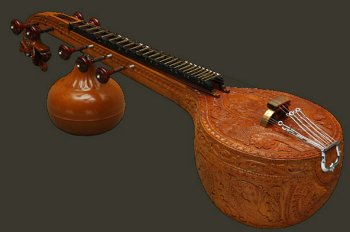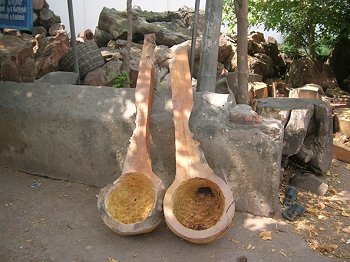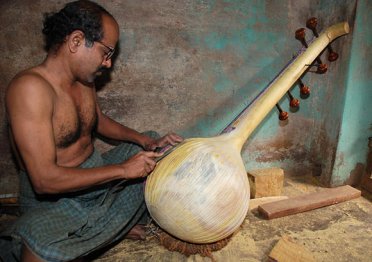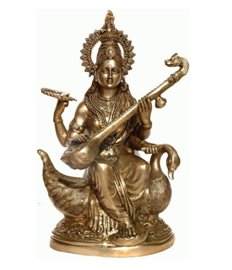
|
 |

|
 |
The Veena - Padma Jayaraj, Thrissur e-mail: padmajayaraj@gmail.com January 4, 2012  The veena is one of the noblest of stringed instruments that belongs to South Indian classical music. Hindu iconography traces its beginnings. Lord Siva is depicted as veena-dhara. And goddess Saraswathi is associated with the veena in popular imagination. Mythically, the invention of the veena is credited to sage Narada. A 19th century lithograph shows the image of a girl playing on the veena. The veena has evolved from the one-stringed instrument in bamboo. Its origin can be traced back to the ancient yazh, a string instrument. Bharata, in his Natya Shastra, explains the theory of the 22 sruti-s in an octave with the help of two experimental instruments, possibly the veena . Several innovations and modifications through countless generations over many centuries shaped and moulded the veena. Its current form is said to be the innovation of Raghunath Nayak of 17th century of Thanjavur in Tamil Nadu. Today there are mainly, three types: Rudra veena, Vichitra veena and Saraswathi veena, associated with classical concerts. Purists, even today, prefer to travel all the way to Thanjavur to order a veena of their choice. Here, once upon a time, when culture was patronized by the royalty, entire streets were lined by the makers of veena. From these streets, from a community life of sharing experience and expertise, the best sprang up with the wisdom of tradition and the individuality of innovation, lauded by patronage and recognized by society. Now ten families, scattered all over Thanjavur are engaged in this craft of making the musical instrument. And individuals keep the tradition alive, art world sponsoring them. 

The making of a veena stems from a team work. The wood cutters select fine jack wood from the villages around. From a huge tree, they say, ten instruments can be made. There is that one-piece- veena which is expensive. A veena can be made by joining three pieces as well. And the price ranges from Rs.7,000 to Rs.10,000. The woodcutter makes a rough hewn, hollow piece and the veena maker starts his work. Thalaimani, a third generation veena maker, explains how he goes about the job. A two-week wood work creates a 1.5 meter long hollow instrument with a round body, wide fretted neck, the end of which is carved into the head of a dragon. A small resonator is attached to the underside of the neck. Its 24 metal frets cast in gunmetal are embedded in hardened bees wax. A combination of metal coils, rings, and strings are tied to the resonator using brass plates. And when complete, music springs from this magic casement; music resonates in different and special frequencies. "The veena made in Thanjavur is the most sophisticated one to date," says Prof. Sambamurthy, the well-known musicologist. Thalaimani has supplied the instruments to individuals and institutions all over the country. The veena is a complete instrument that gives the basic components of sruti, laya and sahitya. Its defining feature is its mellow tonal quality that evokes a meditative mood. "One who is skilled in playing the veena, One who is an expert in the varieties of srutis, One who is proficient in thala, attains salvation without effort." says the Vedic sage Yajnavalkya of the greatness of the veena. Truly, the veena is a noble musical instrument.  Post your comments Please provide your name and email id when you use the Anonymous profile in the blog to post a comment. All appropriate comments posted with name & email id in the blog will also be featured in the site. |